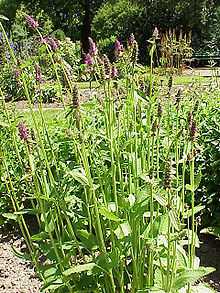Stachys affinis
| Stachys affinis | |
|---|---|
 | |
| Scientific classification | |
| Kingdom: | Plantae |
| (unranked): | Angiosperms |
| (unranked): | Eudicots |
| (unranked): | Asterids |
| Order: | Lamiales |
| Family: | Lamiaceae |
| Genus: | Stachys |
| Species: | S. affinis |
| Binomial name | |
| Stachys affinis Bunge | |
| Synonyms | |
|
Stachys tuberifera Naudin | |
Stachys affinis, the Chinese artichoke, chorogi, knotroot, artichoke betony, or crosne, is a perennial herbaceous plant of the family Lamiaceae. Its rhizome can be grown as a root vegetable. While the plant is easy to grow, the tubers are small, convoluted, and indented, so they are considered very tedious, if not difficult to clean properly. The thin skin ranges from a pale beige to ivory-white colour. The flesh underneath, under proper cultivation, is white and tender. Chinese poets compare it to jade beads.[citation needed] It is in season generally commencing with October.
The flavor of the stem tubers is delicate, and they can be prepared similarly to Jerusalem artichokes in cooking. It is used as a vegetable, in salad compositions, but more so as a garnish. It has a nutty, artichoke-like flavor.
In Chinese and Japanese cuisine, the Chinese artichoke is primarily pickled. In particular, its tuber is a part of Osechi, cooked for celebrating Japanese New Year. Dyed red by leaves of red shiso after pickled, it is called Chorogi. In French cuisine, its cooked tuber is often served alongside dishes named japonaise or Japanese-styled.
External links
- Stachys affinis in Plants for a Future database
 This article incorporates text from a publication now in the public domain: Ward, Artemas (1911). The Grocer's Encyclopedia.
This article incorporates text from a publication now in the public domain: Ward, Artemas (1911). The Grocer's Encyclopedia.